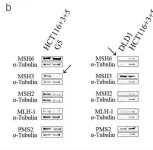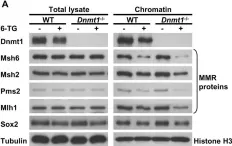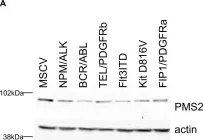Transcription-replication conflicts (TRCs) induce formation of cotranscriptional RNA:DNA hybrids (R-loops) stabilized by G-quadruplexes (G4s) on the displaced DNA strand, which can cause fork stalling. Although it is known that these stalled forks can resume DNA synthesis in a process initiated by MUS81 endonuclease, how TRC-associated G4/R-loops are removed to allow fork passage remains unclear. Here, we identify the mismatch repair protein MutSβ, an MLH1-PMS1 heterodimer termed MutLβ, and the G4-resolving helicase FANCJ as factors that are required for MUS81-initiated restart of DNA replication at TRC sites in human cells. This DNA repair process depends on the G4-binding activity of MutSβ, the helicase activity of FANCJ, and the binding of FANCJ to MLH1. Furthermore, we show that MutSβ, MutLβ, and MLH1-FANCJ interaction mediate FANCJ recruitment to G4s. These data suggest that MutSβ, MutLβ, and FANCJ act in conjunction to eliminate G4/R-loops at TRC sites, allowing replication restart.
Product Citations: 122
In Science Advances on 9 February 2024 by Isik, E., Shukla, K., et al.
-
WB
-
Genetics
In Journal of Gynecologic Oncology on 1 January 2024 by Chao, A. S., Chao, A., et al.
Lynch syndrome (LS) is a hereditary cancer predisposition syndrome with a significantly increased risk of colorectal and endometrial cancers. Current standard practice involves universal screening for LS in patients with newly diagnosed colorectal or endometrial cancer using a multi-step screening protocol (MSP). However, MSP may not always accurately identify LS cases. To address this limitation, we compared the diagnostic performance of immediate germline sequencing (IGS) with MSP in a high-risk group.
A total of 31 Taiwanese women with synchronous or metachronous endometrial and colorectal malignancies underwent MSP which included immunohistochemical staining of DNA mismatch repair (MMR) proteins, MLH1 promoter hypermethylation analysis, and germline sequencing to identify pathogenic variants. All patients who were excluded during MSP received germline sequencing for MMR genes to simulate IGS for the detection of LS.
Our findings indicate that IGS surpassed MSP in terms of diagnostic yield (29.0% vs. 19.4%, respectively) and sensitivity (90% vs. 60%, respectively). Specifically, IGS successfully identified nine LS cases, which is 50% more than the number detected through MSP. Additionally, germline methylation analysis revealed one more LS case with constitutional MLH1 promoter hypermethylation, bringing the total LS cases to ten (32.3%). Intriguingly, we observed no significant differences in clinical characteristics or overall survival between patients with and without LS in our cohort.
Our study suggests that IGS may potentially offer a more effective approach compared to MSP in identifying LS among high-risk patients. This advantage is evident when patients have been pre-selected utilizing specific clinical criteria.
© 2024. Asian Society of Gynecologic Oncology, Korean Society of Gynecologic Oncology, and Japan Society of Gynecologic Oncology.
-
Homo sapiens (Human)
-
Cancer Research
In Nature Communications on 25 September 2023 by Omatsu, M., Nakanishi, Y., et al.
Mesenchymal activation, characterized by dense stromal infiltration of immune and mesenchymal cells, fuels the aggressiveness of colorectal cancers (CRC), driving progression and metastasis. Targetable molecules in the tumor microenvironment (TME) need to be identified to improve the outcome in CRC patients with this aggressive phenotype. This study reports a positive link between high thrombospondin-1 (THBS1) expression and mesenchymal characteristics, immunosuppression, and unfavorable CRC prognosis. Bone marrow-derived monocyte-like cells recruited by CXCL12 are the primary source of THBS1, which contributes to the development of metastasis by inducing cytotoxic T-cell exhaustion and impairing vascularization. Furthermore, in orthotopically generated CRC models in male mice, THBS1 loss in the TME renders tumors partially sensitive to immune checkpoint inhibitors and anti-cancer drugs. Our study establishes THBS1 as a potential biomarker for identifying mesenchymal CRC and as a critical suppressor of antitumor immunity that contributes to the progression of this malignancy with a poor prognosis.
© 2023. Springer Nature Limited.
-
IHC
-
Homo sapiens (Human)
-
Cancer Research
In Medicine on 22 September 2023 by Kaneko, M., Nakashima, M., et al.
Although immunohistochemistry (IHC) for mismatch repair (MMR) proteins (MMR IHC) is used to identify DNA MMR status, universal screening of all patients with colorectal cancer (CRC) using a combination of both MMR IHC and genetic testing for the BRAFV600E mutation is limited in Japan. This study aimed to better understand the histopathological characteristics of CRCs, which exhibit both deficient mismatch repair (dMMR) and BRAFV600E mutation. MMR IHC of formalin-fixed paraffin-embedded tissues from tumor areas obtained from 651 patients with CRC who underwent surgical resection at Hamamatsu University Hospital (Hamamatsu, Japan) between August 2016 and March 2022 were used to evaluate MMR status, which was determined by staining for the expression of 4 MMR proteins (MLH1, MSH2, PMS2, and MSH6). All dMMR tumors were additionally evaluated for BRAFV600 mutation status via Sanger sequencing. Patient clinical characteristics (age, sex, tumor location, size, and tumor pathology) were then classified using their dMMR and BRAFV600 mutation statuses. Among the 651 patients with CRC, 58 carried tumors with dMMR, of which 52 were deficiency in MLH1 (dMLH1). Interestingly, all 16 medullary carcinomas that were analyzed showed characteristics corresponding to the presence of both dMLH1 and BRAFV600E mutation (P = .01). These results suggest that colorectal medullary carcinomas can be diagnosed based on their unique characteristics of harboring the BRAFV600E mutation and exhibiting dMLH1 expression.
Copyright © 2023 the Author(s). Published by Wolters Kluwer Health, Inc.
-
IHC
-
Homo sapiens (Human)
-
Cancer Research
In Science Immunology on 31 March 2023 by Hao, Q., Zhan, C., et al.
Insertions and deletions (indels) are low-frequency deleterious genomic DNA alterations. Despite their rarity, indels are common, and insertions leading to long complementarity-determining region 3 (CDR3) are vital for antigen-binding functions in broadly neutralizing and polyreactive antibodies targeting viruses. Because of challenges in detecting indels, the mechanism that generates indels during immunoglobulin diversification processes remains poorly understood. We carried out ultra-deep profiling of indels and systematically dissected the underlying mechanisms using passenger-immunoglobulin mouse models. We found that activation-induced cytidine deaminase-dependent ±1-base pair (bp) indels are the most prevalent indel events, biasing deleterious outcomes, whereas longer in-frame indels, especially insertions that can extend the CDR3 length, are rare outcomes. The ±1-bp indels are channeled by base excision repair, but longer indels require additional DNA-processing factors. Ectopic expression of a DNA exonuclease or perturbation of the balance of DNA polymerases can increase the frequency of longer indels, thus paving the way for models that can generate antibodies with long CDR3. Our study reveals the mechanisms that generate beneficial and deleterious indels during the process of antibody somatic hypermutation and has implications in understanding the detrimental genomic alterations in various conditions, including tumorigenesis.
-
Genetics
In Clin Transl Gastroenterol on 1 December 2019 by Munakata, K., Koi, M., et al.
Fig.1.B

-
WB
-
Collected and cropped from Clin Transl Gastroenterol by CiteAb, provided under a CC-BY license
Image 1 of 3
In Sci Rep on 25 November 2016 by Wang, K. Y., Chen, C. C., et al.
Fig.4.A

-
WB
-
Collected and cropped from Sci Rep by CiteAb, provided under a CC-BY license
Image 1 of 3
In PLoS One on 30 June 2012 by Pierce, A., Williamson, A., et al.
Fig.6.A

-
WB
-
Mus musculus (House mouse)
Collected and cropped from PLoS One by CiteAb, provided under a CC-BY license
Image 1 of 3


